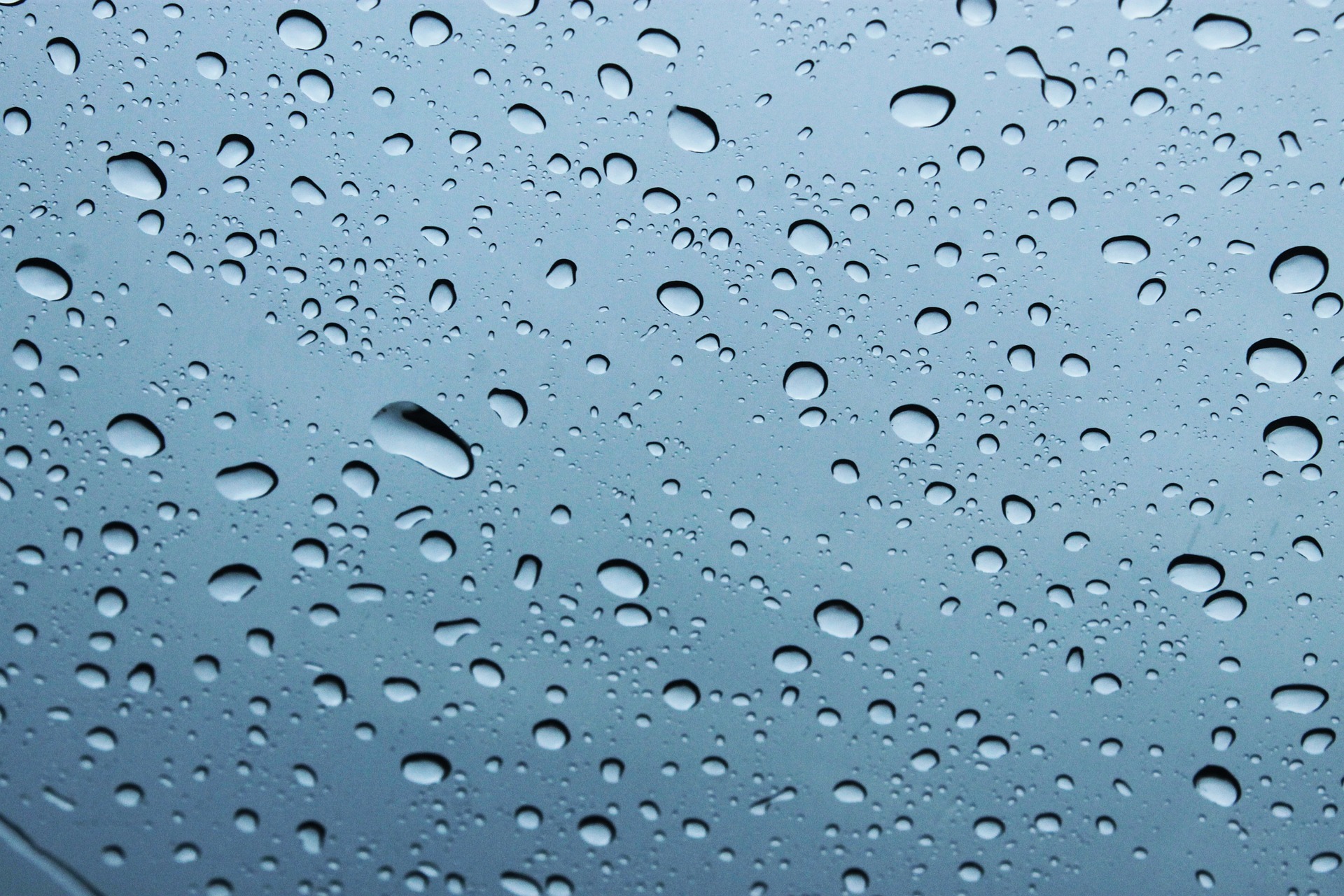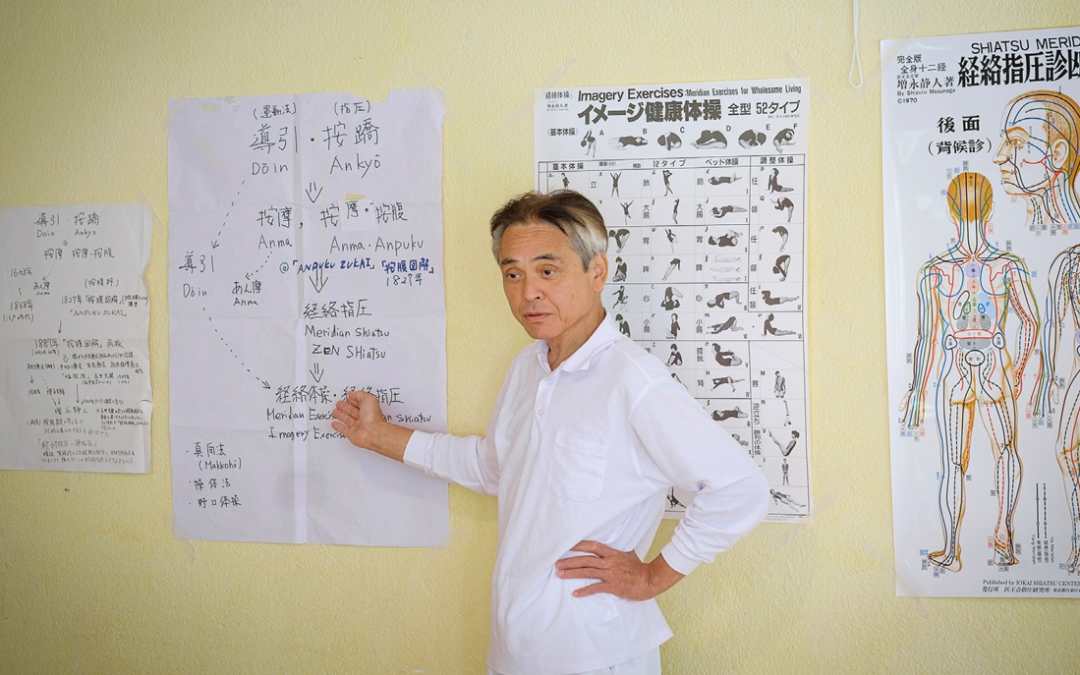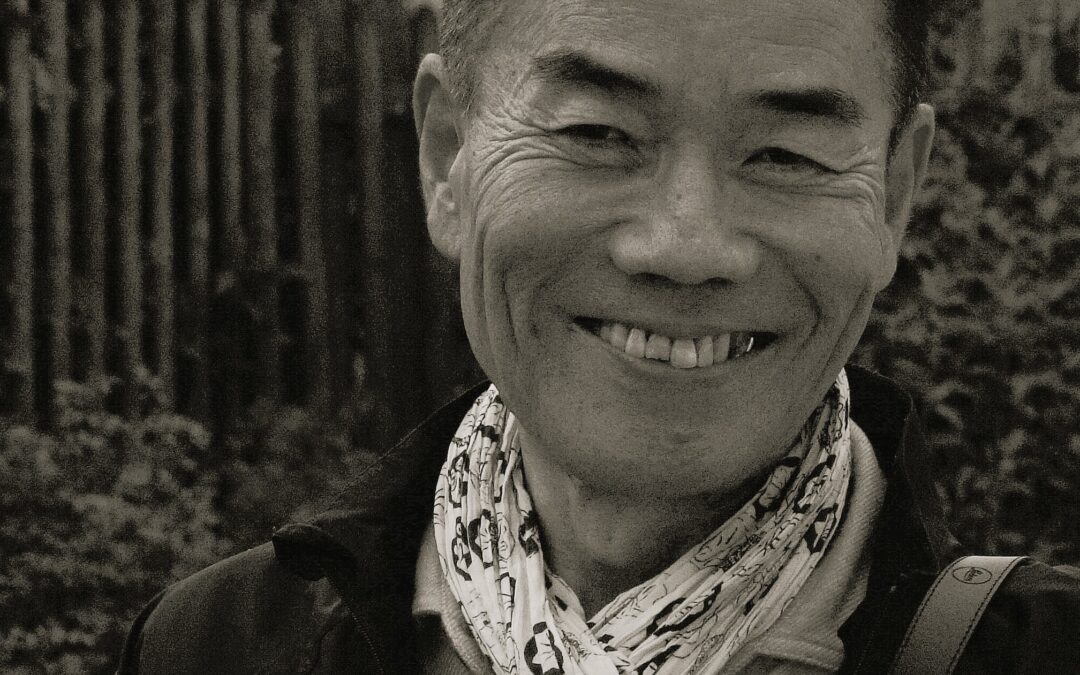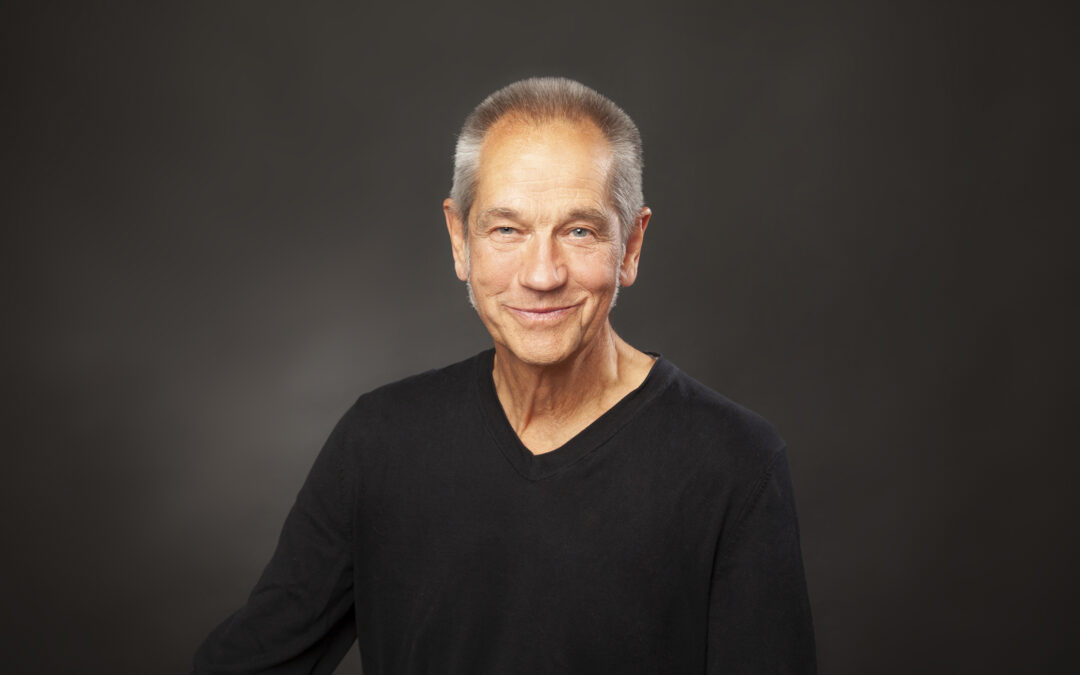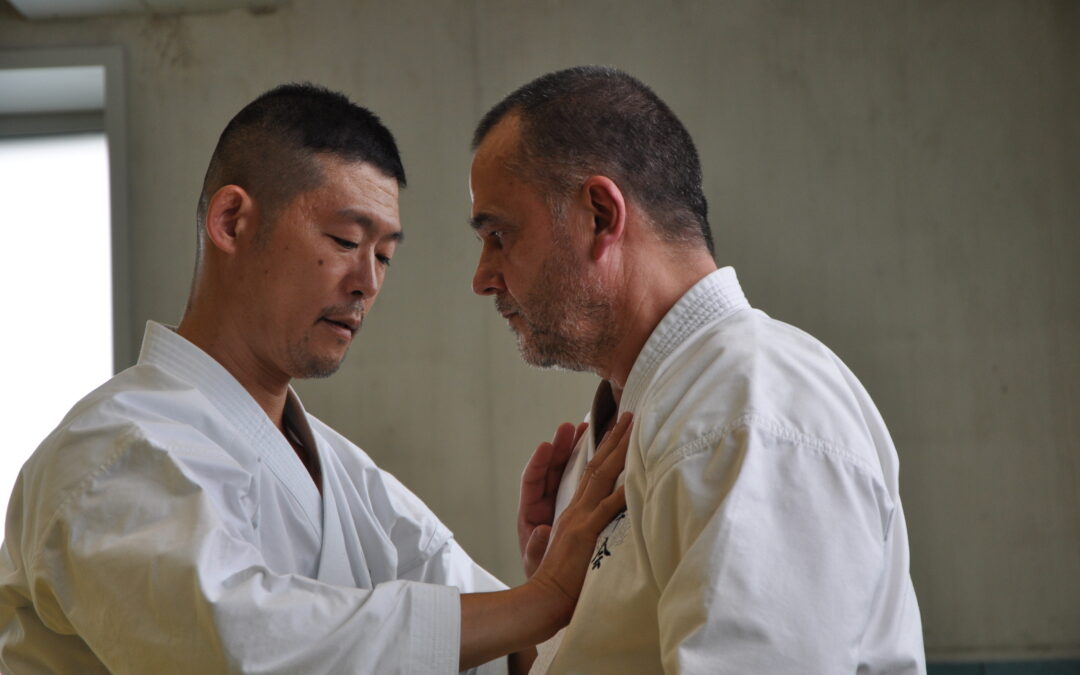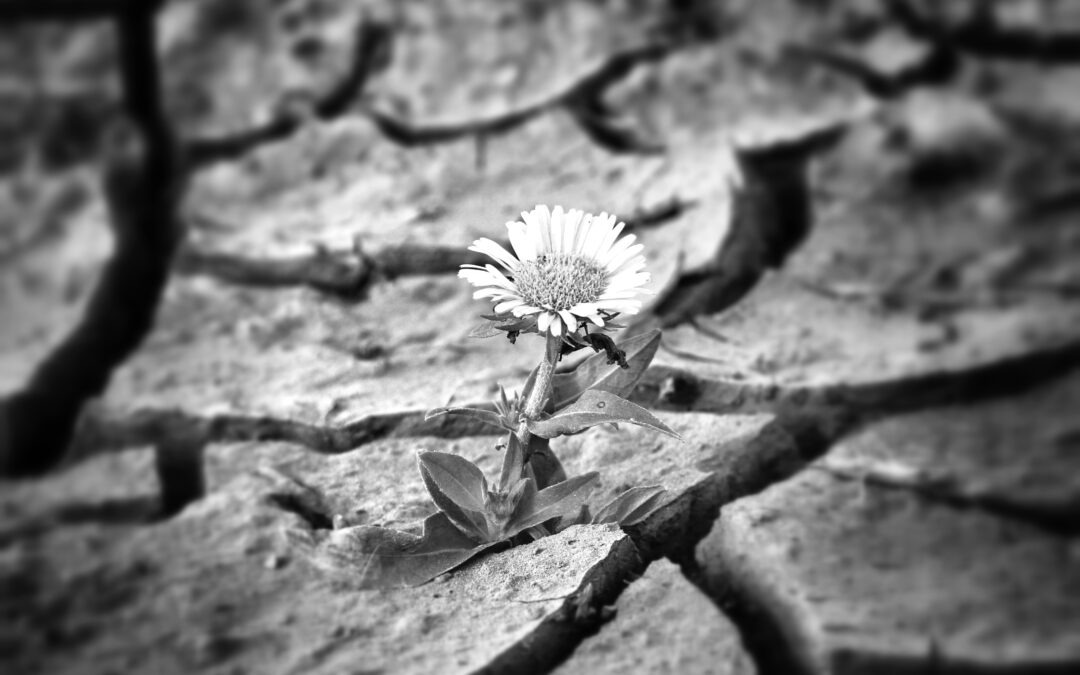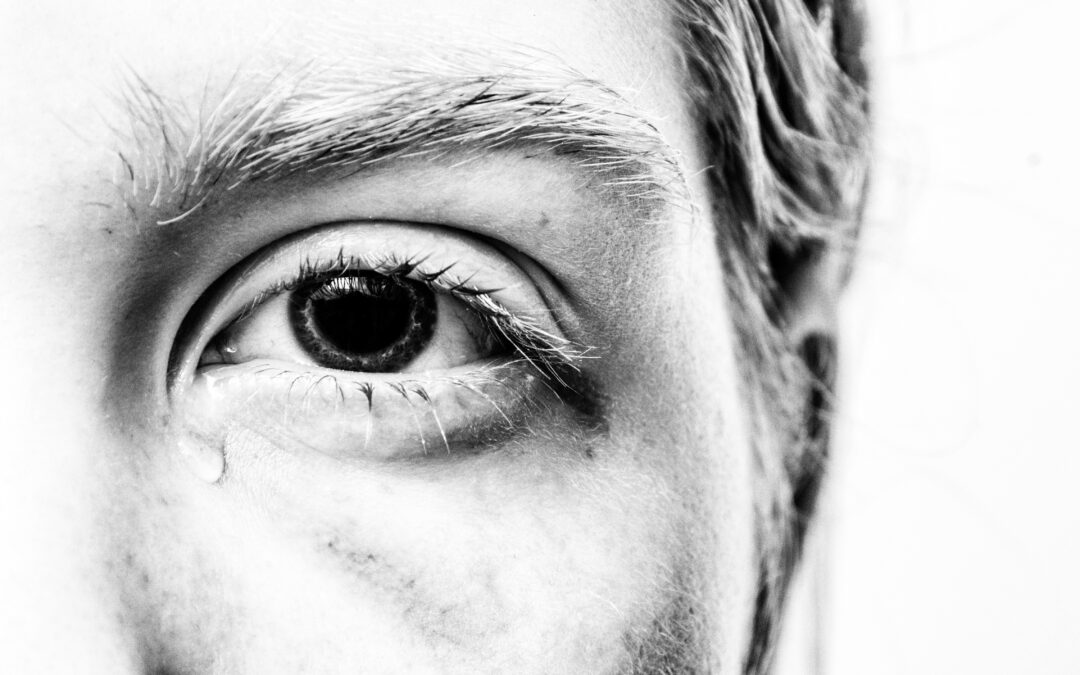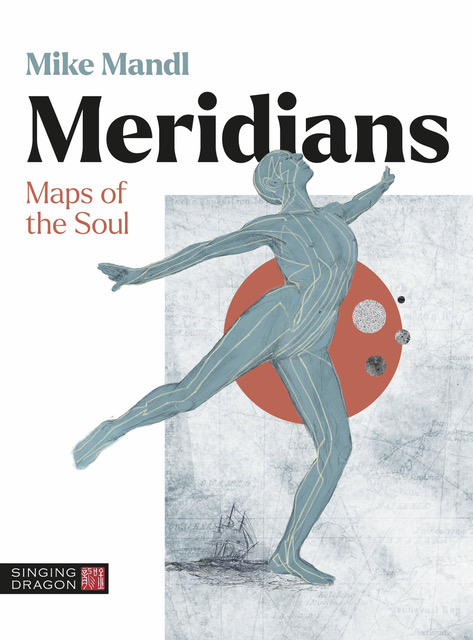With climate change and the chronic drought now taking hold in Europe, this is perhaps a family of points that will tend to be used less and less. Spring and autumn are two seasons when it rains, but you can fall victim to dampness in a cold, poorly ventilated room, by wearing wet socks or, as the Chinese texts say, by “sitting too long on the edge of a well”. That said, in Oriental medicine, Dampness is above all linked to diet and its effects on the body. So, it’s always a good idea to find out which points help to combat dampness. Please note that this article is concerned only with dampness and not with mucus, which is a pathological extension of dampness. Let’s find out more about them.
Dampness-related illnesses
The body needs water, everyone knows that. On the other hand, it doesn’t really like moisture that seeps in. Moisture is the water content of a soil, a wall, or the air. It’s the same for the human body. The presence of humidity (with a capital H to respect the nomenclature of oriental medicine) in the body quickly attacks the skin and respiratory tract if you are not well covered. Humidity can be hot, especially in the tropics, or cold in temperate countries or near the poles, and in both cases it’s quite unpleasant. Snow doesn’t give the same result, as it can be dry on snowy ground, at least until it starts to melt. There are materials that tend to condense moisture, such as metal, glass, or stone (hence the story of the well coping). Once the moisture gets past the skin’s defences, it invades the muscles, tendons, and joints. This is when older people feel their rheumatism coming on.
According to Oriental medicine, Dampness is heavy and sinks. It slows down movement and creates a dull ache in the muscles, because it affects the spleen. It causes swelling, especially in the lower part of the body (hypochondria, thighs, knees, etc.). When Dampness has settled in the body, it can be seen in symptoms such as cloudy urine, vaginal discharge, acute skin diseases with papules or vesicles, and acute digestive problems.
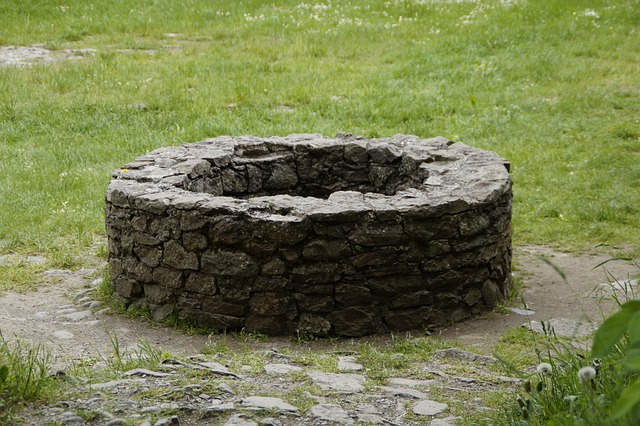
According to Western medicine, dampness causes inflammation of the respiratory tract and skin. One of the reasons given for this is mould in damp houses, which can cause allergies, leading to respiratory and skin problems and inflammation. Rheumatism, arthritis and osteoarthritis are also included in this table. Finally, as in Chinese medicine, Humidity will tend to create oedemas, particularly on the legs and especially in hot, humid climates.
As the opposite of humidity is dryness, providing dry heat goes a long way to solving these problems. So, either take a trip to a warm, dry country, or use moxibustion or the Chinese Wai Qi lamp to get rid of the dampness.
Evacuation of Dampness
As the Qi gong treatises say, “running water does not stagnate”. Consequently, as a general rule, the treatment consists of dissipating the Dampness, which is always in danger of stagnating, to evacuate it. While we know that the Spleen is always the biggest victim (or the cause of empty Qi) of the presence of Dampness, it is up to two organs to evacuate the overflow. We’d also like to add a few other organs which we don’t think about as much, but which nevertheless have a role to play.
1. The lung: as you can see, when you talk a lot, at a conference for example, your mouth is always dry. So, it’s no coincidence that the organisers always place a glass and a bottle of water next to the speaker, even if he’s a footballer who just says he’ll do better next time. So, you lose a lot of moisture through your mouth, which is why desert people put a cloth over their mouths and breathe only through their noses. Finally, spittle can be expelled through the mouth, another way of evacuating moisture.
2. The Bladder: this is rather obvious, but the Bladder, which receives wastewater filtered by the Kidneys, will have to retain, and then expel this water. The presence of moisture can be seen in cloudy urine. It is also an organ to be stimulated to increase the final evacuation.
3. The intestines: we don’t always think about it, but as soon as the spleen is weak, the stools become loose. And if it’s the intestines that get cold, it’s not long before you have a dazzling case of watery diarrhoea. The intestines are therefore a less frequent means of evacuating water.
4. The stomach: even rarer, and fortunately, water can be lost through vomiting. The stomach is also responsible for the entry of liquids into the body. Consequently, it will have many opportunities (along with the Spleen) to regulate Moisture, as we shall see.
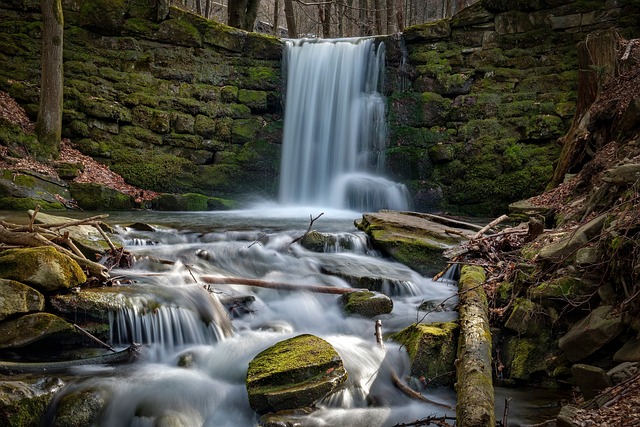
Worth noting
Who can do more of doing less! Since we don’t want to restrict you to the traditional lists for treating Dampness, you’ll find below a more extensive list of points which deal with expelling the overflow of Dampness which is one of the most classic attacks in Oriental medicine. Obviously, that’s a lot of points, especially as we’ve added points which help to evacuate water, i.e. which encourage urination, because that goes with it. Once you’ve got the moisture moving, you need to get it out.
Be careful not to confuse the points that fights Dampness with the points that help to re-humidify (i.e. conserve or prevent loss) the body. What’s more, this article is dedicated to Moisture and its evacuation and not to Mucositis, even if these are sometimes the same points, as you’ll see in the detailed descriptions below.
Finally, given the sheer number of useful points, we’ve added maps for each meridian to give you a better understanding of how these points are organised. It’s obvious that they are mainly located in the abdomen, the lower back, and the legs, which clearly demonstrates what the theory says, namely that Humidity is heavy and descends. That’s why you’ll have more water retention in your legs than anywhere else in the body.
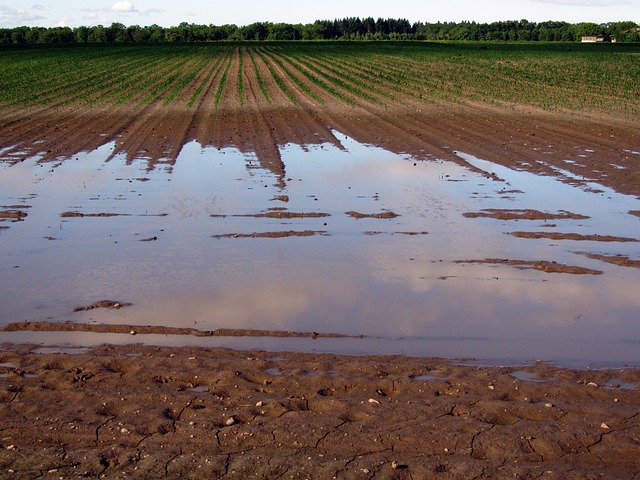
Summary of points
- Lungs :LU7
- Large Intenstine : Li11, Li13, Li17, Li18
- Stomach : ST25, ST27, ST28, ST31, ST32, ST33, ST35, ST36, ST37, ST38, ST39, ST40, ST44
- Speen/Pancreas : SP2, SP3, SP4, SP5, SP6, SP7, SP8, SP9, SP11, SP12
- Small Intestine : SiG4, SiG6,
- Bladder : BL12, BL19, BL20, BL22, BL23, BL27, BL28, BL31, BL35, BL40, BL48, BL49, BL50, BL53, BL57, BL60
- Kidneys : Ki7, Ki8, Ki10, Ki14
- Triple Heater : TH11, TH14, TH15
- Gallbladder : GB24, GB26, GB30, GB31, GB32, GB33, GB34, GB37, GB39, GB40, GB43
- Liver : LivF5, Liv6, Liv7, Liv8, Liv9, Liv10, Liv13
- Conception Vessel : CV1, CV3, CV5, CV9
- Gouverneur Vessel : GV2, GV3, GV6, GV9
The points in detail
Lung

LU7 (列缺 Liè quē) : Broken Sequence
Located 1.5 cun from the distal wrist crease, in the proximal depression of the styloid process. Luo point and key point of the Conception Vessel (Ren Mai).
- Recommended for points against dampness, as it helps the Lung to diffuse dampness and treats inflammation of the Wind-Moisture (rhinitis, sinusitis, coughs, asthma).
- Also treats neck pain, torticollis, etc.
- In cases of Trismus (involuntary contraction of the mouth that no longer opens), facial paralysis, epilepsy, etc.
Large Intestine

LI11 (曲池 Qū chí): Marsh of the curve.
Sea point (He) Earth point and Ben point of the 5 ancient Shu. Eliminates Heat, cools and regulates Blood, drives out external perversity (Wind, Dampness, Heat) and drains Dampness. A well-known point indicating inflammation of the large intestine, it is found on an elbow bent at 90°, in the middle of the line joining the P5 to the epicondyle of the humerus.
- Normalizes fever (in combination with LI4 and GB14)
- Relieves painful throat obstruction, aphonia and toothache.
- Treats nervous agitation, tightness in the chest and manic behaviour.
- Calms arterial hypertension (with ST36, ST40 and Ki1), strengthens myocardial contraction.
- Treats headaches and migraines
- Good in cases of wind or allergic dermatitis
LI13 (手五里 Shǒu wǔ lǐ): Arm Five Miles.
Stimulates the GI meridian, relieves pain, regulates Qi, drains Dampness and transforms Mucus. It is located on the outer edge of the humerus, 3 cun from the elbow crease.
- Treats cough, difficulty breathing
- Blood vomiting
- Jaundice, malaria, lymph nodes
LI17 (天鼎 Tiān dǐng) : Heaven’s Tripod.
The 1st of the two LI points on the neck, it is located on the posterior edge of the SCM, 1 cun below LI18. Disperses heat from the throat, has a beneficial effect on the throat and voice, eliminates sputum and therefore eliminates dampness/mucus.
- Laryngitis, angina, aphonia
- Tuberculosis of the lymph nodes in the neck
- Goitre
LI18 (扶突 Fú tū): Support the Prominence.
On the horizontal line with the Adam’s apple, 3 cun to the outside, between the sternal and clavicular heads of the SCM. This is one of the Heaven’s Window points (reputed to chase away the Wind), eliminates abundant sputum/phlegm.
- In cases of aphonia, swelling and pain in the throat.
- Coughing up sputum/phlegm, wheezing, asthma
- Hypotension, goitre, lymph nodes
Stomach

ST25 (天樞 Tiān shū): Heaven’s Pivot
Placed 2 cun to the side of the navel, it is the Mu point of the Large Intestine. Like the latter, it will have an action of eliminating Heat-Humidity and stagnation in the Stomach, Spleen, and Intestines.
- Dissipates oedemas, distension of the stomach, intestinal seclusion, intestinal mass
- Combats painful urinary disorders
- Vomiting, retching, nausea
- Difficulty swallowing, poor appetite
- In women, pain in the uterus
ST27 (大巨 Dà jù): Great Pearl
Among its effects, it teases the Kidneys, consolidates Jing and Qi and encourages urination (thus evacuating water). It is used in addition to the other points which deal with Dampness to complete its evacuation. It is found 2 cun below E25.
- Distension and fullness of the pelvis, dysuria, seminal discharge
- Constipation
- Insomnia
- Fear-like palpitation
ST28 (水道 Shuǐdào): Water Passage
The name alone gives away the point. Located 3 cun below ST25, it regulates the Bladder and the Uterus, and frees the Water Way (which means it promotes urination). It is therefore another point for the evacuation of excess Moisture.
- Combats retention of urine and faeces.
- Combats distension and fullness from the lower abdomen to the genitals.
- Combats cold in the uterus, infertility, and uterine pain.
ST31 (髀关 Bì guān): Thigh Gate
The 1st point of the Stomach on the thigh (at the intersection of the ASIS and the lower edge of the pubis), you wouldn’t necessarily expect to find a point against Dampness here. Those on the stomach seem more logical. And yet, it is reputed to chase away Wind-Humidity and relieve local hip pain.
- Atrophy, muscle weakness and painful obstruction syndrome of the lower limb (Cold or Damp type)
- Leg numbness, hip pain, thigh pain, lumbar sciatica.
ST32 (伏兔 Fú tù): Crouching Rabbit
6 cun superior to the upper edge of the patella, it relieves pain and drives out the Wind-Humidity, like the previous point. Its action in gynaecology (not listed here) and dermatology is much appreciated.
- Lumbago, hernia, gonalgia
- Local pain or paralysis of the lower limbs
- Skin rash all over the body
ST33 (阴市 Yīn shì): Yin Market
Another point on the thigh, 3 cun superior to the upper edge of the patella, between the rectus anterior and vastus lateralis. It drives away Wind and Dampness, relieves pain, and has an effect on the shoulder.
- Atonia or pain in the lower limbs
- Sensation of cold water in the lower back and knees
- Difficulty stretching or bending legs and knees
- Stiffness and pain in the shoulder
- Distension of the pelvis
ST35 (犊鼻 Dú bí): Calf’s nose
Found in the depression on the lower edge of the patella (kneecap). Same effects as above (repels Wind and Dampness, relieves pain) and reduces swelling.
- As a local point, reduces swelling of the knee
- Atonia or pain in the lower limbs
- Gonalgia
ST36 (足三里 Zú sānlǐ): Leg Three Miles
One of the big stars among the points, ST36 does just about everything. It is a Sea (He) point, Earth point, Ben point, lower Sea point of the Stomach, it drives out and circulates Dampness, fortifies the Spleen, strengthens Yuan Qi, nourishes Blood and Yin, eliminates Fire and calms Shen. Revives Yang and restores consciousness.
- Diarrhoea, oedema, heaviness, abdominal pain, nausea
- Treats all problems caused by insufficient Qi and Yin
- Manic depression, delirium, anger, foul language, agitation, inappropriate laughter
- Rheumatism, atrophy, hemiplegia
- Mastitis
- Respiratory disorders such as asthma
ST37 (上巨虛 Shàng jù xū): Upper Great Void
Directly 3 cun below ST36, it is the Sea (He) point of the LI. It regulates the intestines, dissolves stagnation, eliminates Heat and Dampness, relieves pain particularly in the Stomach and Spleen.
- When Dampness invades the Spleen, it causes chest tightness (with PC6, CV12, 17CV).
- Diarrhoea, constipation, nausea, and vomiting
- Bloody stools, prolapse
- Eczema
- Appendicitis
- Atony and pain in the lower limbs, muscle atrophy
ST38 (條口 Tiáo kǒu): Lines Opening
This point disperses the Wind, eliminates Dampness, calms pain, effect on the shoulder. Located 2 cun below ST37 or 8 cun above the lateral malleolus.
- Atrophic syndrome and Bi of the lower limbs
- Sciatica
- Gonalgia
- painful obstruction” syndrome due to an external cause (cold wind and damp), which causes arthritis and sciatica. Shoulder pain
ST39 (下巨虛 Xià jù xū): Lower Great Void
Located 1 cun below ST38 or 7 cun above the external malleolus, this is another lower Mer point, this time on the GI. It transforms stagnation, eliminates Heat and Dampness from the intestines and relieves pain. Incidentally, it is also a point which promotes lactation.
- Treats GI disorders, diarrhoea with undigested food
- Pain in the lower pelvis, low back pain
- Mammitis
- “Painful obstruction” syndrome due to an external cause (cold wind and damp), which causes arthritis and sciatica.
- Manic delirium, sudden fright
ST40 (丰隆 Fēng lóng): Abundant Bulge
ST40 indicates the bifurcation (or zigzag) of the Stomach meridian on the leg. To find it, the easiest way is to go back to ST38 and move 1 cun outwards, or 2 cun sideways in relation to the tibia. This is a Luo point, but above all it’s the big point that fights against mucus (phlegm). It eliminates them and drives out Dampness, brings down Qi and disperses Fire.
- It helps the Lung in cases of coughing, dyspnoea, asthma, wheezing and mucus.
- If the Heart is affected, it calms the Shen, tightness, and pain in the chest, swelling of the face and high blood pressure.
- Combats headaches
- Helps with problems with urination or defecation.
- In psychology, it is used against manic-depressive disorders, agitation, epilepsy, and plum pit syndrome.
ST44 (内庭 Nèitíng): Inner Courtyard
This is the penultimate point of the Stomach, located 0.5 cun away in the crease between the 2nd and 3rd toe. A gushing point in the ancient 5 Shu (Ying) and a Water point, it therefore has a calming action on the Heat and Fire on its meridian, relieves pain, harmonises the intestines and eliminates Heat-Humidity, while calming the Shen.
- Treats angina and sore throats
- Treats toothache and nosebleeds
- In cases of facial paralysis, frontal headaches
- Diarrhoea and constipation, thirst, bad breath
- Insomnia, mental agitation, psychosis, hysteria, nightmares
Spleen

SP2 (大都 Dà dū) : Great Metropolis
As with the Stomach points on the leg, many of the Spleen points are used to combat Dampness, as both are responsible for the level of Dampness in the body and its circulation. SP2 is the Ying point and a Fire point. Its job is to regulate Humidity or Heat-Humidity. It harmonises the median focus (ST-SP) and eliminates heat.
- Treats obstructions, such as gout, but also swelling of the 4 limbs
- Abdominal distension, epigastric pain, vomiting
- Diarrhoea and constipation
- Restlessness when hungry and dizziness when full
- Worry, insomnia, anxiety
SP3 (太白 Tài bái): Great White or Supreme White
This is the Source (Yuan) point of the Spleen meridian, located on the inside of the big toe, under the head of the 1st metatarsal, at the boundary between red flesh and white flesh. Both a River point in the ancient 5 Shu, a Source point and a Ben (root) point, it tones the Spleen, eliminates Humidity or Heat-Humidity, and harmonises the Stomach-Spleen couple.
- Epigastric pain and diarrhoea in cases of Emptiness, abdominal distension, borborygms
- Regurgitation, nausea and vomiting, hiccups
- Metrorrhagia, leucorrhoea, hypogalactia, chest distension
- Fatigue, swollen legs (in combination with SP9)
- Hunger with lack of pleasure in eating
- Stimulates intellectual power in people suffering from post-viral fatigue
SP4 (公孙 Gōng sūn): Grandfather and grandson /Yellow Emperor
Located 1 cun behind SP3 in the same free space on the inner side of the foot, where the finger stops against the 1st metatarsal bone. The name of this point indicates that it acts on the heritage and it is the opening point of the Penetrating Vessel (Chong Mai) as well as the Luo point of the Spleen. It frees the meridian, opens the Chong Mai and regulates the intestines, stomach and Qi. Eliminates dampness and calms the Shen.
- Stomach pain and vomiting
- Combats cold in the stomach, lack of pleasure in eating, abdominal and umbilical distension.
- For the intestines, eliminates borborygms, diarrhoea, poorly digested food in the stools and the presence of blood.
- Psychological: manic-depressive disorders, sighing, insomnia, agitation, anxiety, epilepsy.
- In gynaecology: irregular periods and various menstrual disorders
- Swelling of the face, malaria, jaundice,
- Heel pain, heat in the sole of the foot.
SP5 (商丘 Shāng qiū): Shag Mound
River point and Metal point, SP5 is located in the depression in front of and below the centre of the inner malleolus of the foot. It strengthens the Spleen and eliminates Dampness, clears the Shen, but also has a beneficial effect on the bones and tendons.
- It is used in cases of Spleen Emptiness, with drowsiness, lethargy, and a desire to go to bed.
- Abdominal distension, borborygms, watery diarrhoea, poorly digested food in the stools or constipation
- Sharp cold pain in the epigastrium, obstruction of the meridian
- Haemorrhoids due to heat and dampness
- Aphonia, cough
- Sterility
- Psychological: manic-depressive, depression, anxiety, excessive thoughts, inappropriate laughter, nightmares, melancholy
- Tightness of tendons, heaviness of the body, painful joints
SP6 (三阴交 Sān yīn jiāo):Three Yin Crossing / Intersection (of the leg)
Another famous and often-used point, SP6 crosses the Spleen, Kidney, and Liver. It tones all the functions of the Spleen and Kidney and harmonises the Liver. In short, it invigorates the Yin and therefore eliminates Dampness, and refreshes and circulates the Blood.
- All the Kyo or Jitsu tables for the Spleen
- Plenitude of the Heart and Abdomen
- Gynaecological: regulates menstruation, combats sterility and prolapsed uterus
- Uro-genital: regulates micturition, beneficial effects on the genitals (spermatorrhoea, sexual hyperactivity or impotence).
- Dermatological: eczema, urticaria
- Dizziness, tinnitus, yawning, hypertension
- Painful obstruction syndrome of Moisture in the leg, hemiplegia, pain in the sole of the foot and tibia
- Psychological: loss of memory, agitation, insomnia, psychosis, epilepsy, dreams that disturb sleep, depression, hysteria, shyness
- Stagnation of body fluids associated with oedema of the lower limbs in combination with ST36, CV6 CV12
SP7 (漏谷 Lòu gǔ): Dripping Valley
The name of the point could not be more explicit. It evacuates Dampness and therefore encourages urination. It also disperses swelling. 3 cun above SP6 or 6 cun from the medial malleolus, against the tibia.
- Abdominal fullness
- Borborygma, diarrhoea, painful eructation.
- Atrophy of muscles and flesh despite normal diet
- Leg oedema, cold legs
- Difficulty urinating
SP8 (地机 Dì jī): Earth Pivot
Crevasse (Xi) point of the Spleen, it is located 3 cun below SP9, against the edge of the shin. Regulates menstruation and invigorates Blood, eliminates Dampness and dispels acute pain on the Spleen and its meridian.
- Eliminates Blood stasis
- Dysmenorrhoea of all types
- Dissolves cysts
- Insufficient sperm, male sterility, abundant vaginal humours, or dryness
- Sensitive after drinking alcohol or stomach disease
SP9 (阴陵泉 Yīn líng quán): Yin Mound Spring
Sea point (He) and Water point among the 5 ancient Shu, this point is located at the top of the tibia, it is the Great point of Dampness syndromes concerning the intestines, Bladder, genitals and GBL.
- Disperses Cold and Dampness, tonifies the yang of the Spleen
- Abdominal distension, lower abdominal pain
- Oedema, swelling of lower limbs
- Difficulty urinating, enuresis, painful urinary problems
- Dyspnoea with inability to lie still
- Swelling of the knee, Bi of the leg
SP11 (箕门 Jī men): Winnowing gate
At 8 cun from the superior-internal border of the patella, on the medial border of the couturier next to the femoral artery. It regulates urination, clears Heat and eliminates Humidity. Note: in passing that this is a Gate point which brings the external into the internal and vice versa (read the article on Gate points).
- Treats groin lymph nodes, swelling of the inguinal ligament
- Painful urinary problems, urine retention, enuresis
- Scrotal eczema, pruritus of the moist genital type
- Lower abdominal pain
SP12 (冲门 Chōng mén): Rushing Gate
Here’s another point that drains Dampness, eliminates Heat and promotes urination, but it’s the last one on this meridian. It is found very close to the femoral artery (hence the name “beats”), on the upper line of the pubis, 3.5 cun from the symphysis.
- Abdominal pain and masses
- Cold and fullness of the abdomen
- Haemorrhoidal pain
- Urinary disorders
- Lactation problems
Bladder

BL12 (风门 Fēng mén) : Wind Gate
For the Bladder, everything starts at the 1st point on the back. BL12 not only disperses Wind, but also Cold, Heat and external Humidity (that which seeks to enter). It’s therefore the 1st point that will boost Tai Yang energy to chase away any intrusion. It is found 1.5 cun from the T2, just above the Bei Shu (Yu) point of the Lung.
- Treats coughs, colds, asthma, sinusitis, bronchitis, and all respiratory ailments.
- Combats eczema, allergies, oedema, rheumatism
- Eliminates headaches
- Chest and shoulder pain
- Useful as a treatment for restless sleep
BL19 (胆俞 Dǎn shū): Gallbladder transporter
We begin the list of Bei Shu (or Yu, see the article on Bei Shu points) points with the Gallbladder point, 1.5 cun from T10. It dispels the Heat-Humidity of the Liver and the Gallbladder, invigorates its Qi and harmonises the Spleen and Stomach. This relationship with the ST/SP couple gives us a better understanding of the link with Humidity.
- Bitter taste in the mouth, vomiting, nausea
- Dysphagia (difficulty swallowing)
- Swelling of the armpits, tightness of the diaphragm, chest pain
- Chest distension and pain
BL20 (脾俞 Pí shū): Spleen Transporter
Obviously, the Bei Shu point of the Spleen will intervene to reduce Dampness, tonify the Yang and Qi of the Spleen and retain Blood. Located 1.5 cun from T11 in the 11th EIC, this point has many actions.
- All the problems caused by an Empty Spleen
- Abdominal pain and distension, diarrhoea, vomiting, epigastric pain
- Headaches, dizziness, general weakness, heaviness in the body, not wanting to move
- Insomnia or hypersomnia, as the case may be
- Lack of milk, irregular periods, and all menstrual disorders
- Haemorrhage, ptosis (organ descent) and prolapse
BL22 (三焦俞 Sān jiāo shū): Triple Heater Transporter
Two notches lower, facing L1, still 1.5 cun to the side, we find BL22. Linked to the TH (the Way of the Waters), it triggers the activity of the middle and lower warmers and therefore eliminates Dampness, promotes urination and eliminates masses. The perfect point to relieve swelling.
- Treats gastro-oesophageal problems, borborygmi, difficulty swallowing, diarrhoea with undigested food, vomiting, constriction of the oesophagus, etc.
- Abdominal distension and masses with abnormal weight loss in women
- Large, hard masses in the hypogastrium
- Oedema, difficult micturition, turbid urine,
- Bitter taste, chapped lips, jaundice
- Stiffness and pain in the spine, shoulder and back.
BL23 (肾俞 Shèn shū): Kidneys Transporter /Vitality Gate
It’s no surprise that the Kidneys are involved, as it controls urination and defecation, has effects on the uterus and warms it, nourishes the eyes the ears and the Jing, relieves the loins, and finally eliminates Dampness and the full body of water. It is found 1.5 cun on each side of the L2.
- Headaches and dizziness, tinnitus, deafness
- Head trauma, hair loss
- Dyspnoea, asthma
- Lumbago, vertebral pain
- Impotence, spermatorrhoea, male sterility, enuresis (involuntary urination), oliguria (weak urine) anuria (absence of urination)
- Irregular periods, threat of abortion, menstrual disorders, prolapse of the uterus, infertility in women
- Tearing, sudden loss of vision
- Kidney pain
BL27 (小腸俞 Xiǎo cháng shū): Small Intestine Transporter
1.5 cun to the side, level with the 1st sacral foramen of the sacrum is BL27 which is related to the LI. It regulates the Bladder and the Intestines, eliminates Heat-Humidity and Humidity. Easy to find, it will be of great help in our problem of the day.
- Diarrhoea and constipation, haemorrhoids
- Difficulty passing urine, seminal discharge, enuresis, white discharge, haematuria (blood in the urine)
- Testicular pain that radiates to the lumbar region
- Swelling of the lower abdomen that cannot withstand any pressure
- Thirst problems, dry mouth that is difficult to tolerate
- Low back pain
BL28 (膀胱俞 Páng guāng shū): Bladder Transporter
1.5 cun to the side, level with the 2nd sacred hole is the Bei Shu point of the Bladder. The recognised effects are more or less the same. Eliminates heat-moisture from the lower abdomen (Ki-BL), disperses stagnation and masses, has beneficial effects on the lumbar vertebrae and legs.
- For fullness syndromes, it is combined with SP9 and CV3.
- Stranguria (slow painful urination, dripping; straining to pass urine), dysuria, enuresis.
- Seminal loss, pain in the genital area with swelling and irritation.
BL31 (上髎 Shàng liáo): Upper Bone Cervice
This time, located in the line closest to the midline, right in the 1st sacral hole, BL31 strengthens the lumbar vertebrae and legs and promotes urination.
- – regulates menstruation
- – calms leucorrhoea
- – facilitates urination and defecation
- – increases contractions during childbirth.
BL35 (会阳 Huì yáng): Meeting of Yang
Located 0.5 cun from the tip of the coccyx, it regulates the intestines and the lower foyer, and eliminates Dampness. Given its location, its effects are primarily local.
- – Combats chronic haemorrhoids, rectal prolapse, pruritus or swelling of the genitals
- – White discharge, impotence
- – Diarrhoea, blood in the stools
- – Pain in the coccyx, lumbar region, and leg
BL40 (委中 Wěi zhōng): Middle of the Crook/Bend
This is a Sea (He) and Lower Sea point, Earth point in the ancient 5 Shu. It is above all a Master point of the back and lumbar region in cases of acute or chronic pain. As its name suggests, it is at the centre of the popliteal fossa, and is reached when the knee is bent. It dispels toxic Heat or Plenitude (in dermatology), dissolves Blood stasis, unblocks the meridian, activates the Luo, and helps against illnesses caused by Summer Heat and Humidity.
- All lumbar problems, from the buttock, sacrum, coccyx, thigh, and knee to the big toe.
- Atrophy of the lower limbs, sciatica, “painful obstruction” syndrome due to an external cause (cold wind and damp)
- Purpura, skin inflammation, furuncle, pruritus (back and legs), erysipelas (red, swollen, and painful spots)
- Haemorrhoids
- Simultaneous vomiting and diarrhoea
- To chase away dampness, classic combination with ST36, SP6 and BL57
BL48 (阳纲 Yáng gāng): Yang’s Key Link
We are back on our backs, on the second line of the Bladder. BL48 is 3 cun to the side of T10. It eliminates Heat-Humidity and regulates the Gall Bladder.
- – Borborygia, stomachache, diabetes, jaundice
- – Dark and hesitant urination
- – Nonchalance, drains anxiety.
- – Difficulty swallowing, lack of pleasure in eating, distension, and pain in the stomach.
- – Spasms of the GB
- V49 (意舍 Yì shě): House of ideas
At the level of the T11 and 3 cun lateral to the central line of the back, V49 regulates the Spleen-Stomach pair and eliminates Heat-Humidity.
- – It stimulates the intellectual faculties.
- – Swollen and painful stomach, borborygms, stagnant food
- – Distension and pain in the chest and hypochondria
- – Diarrhoea, vomiting
- – Reddish-yellow urine, heat in the body and yellow eyes
BL50 (胃仓 Wèi cāng): Stomach Granary
Still on the second line of the Bladder 3 cun to the side, level with T12, it eliminates Dampness and regulates the median focus and Qi.
- – Abdominal fullness, Emptiness-type distension
- – Difficulty swallowing, infant malnutrition
- – Fear of cold, cold in the back
- – Eliminates oedema
BL53 (胞肓 Bāo huāng): Bladder’s Vital
This point, which always intrigues because of its name, is located 3 cun from the 2nd sacral hole of the sacrum. It is a good evacuation point, as it aids urination and defecation, relieves pain and strengthens the lumbar region.
- – Hardness and swelling of the hypogastrium, borborygms, poorly digested food
- – Urine retention, drip urination
- – Oedema
- – Lumbago, sciatica, bladder or anal tenesmus (painful tension)
BL57 (承山 Chéng shān): Support the Mountain
To find it, you have to pass between the twin calf muscles and it is in the BL at the end of these muscles, halfway between BL40 (popliteal fossa) and BL60 (Achilles tendon fossa). It unblocks the entire Bladder and activates the Luo, so it’s a good evacuation point (for urine and faeces). It disperses stagnation and excess pressure caused by heat. Finally, it relieves cramps and tendons.
- All types of haemorrhoids, rectal prolapse, anal fissure.
- Lateral lumbago, sciatica, inability to stand upright.
- Cramps, tendon contractures, Bi in the lower limbs, muscle atrophy.
- Disperses water and faeces only.
- Eliminates dampness in combination with CV12, LI11, ST36 and ST25
BL60 (昆仑 Kūn lún): Kunlun Mountains
Another very large Bladder point, BL60 is located in the hollow of the external depression of the Achilles tendon. River point and Fire point of the 5 ancient Shu, it therefore eliminates Heat and brings down Yang. Soothes the Wind, stimulates the entire meridian and circulates water, relieves pain at a distance (distal point). It is used to promote childbirth, relax tendons, and strengthen the spine.
- Against dampness in combination with SP9
- Against oedema in combination with SP9, SP6 and LU7
- Dispels Blood stasis
- Treats epilepsy, madness, headaches, glare, redness and heat of the eyes
- Rhinitis with nosebleed
- Stiffness of the neck, shoulder and back
- Heart pain radiating to the back, lumbar pain, sacrum, coccyx, sciatica
- Knee and ankle pain
- Chest fullness, dyspnoea, coughing
- Difficulty in reproduction and childbirth, swelling of genitals
Kidney
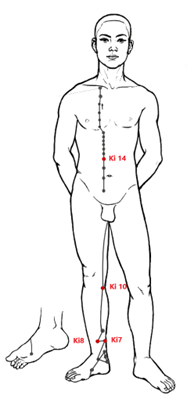
Ki7 (复溜 Fù liū): Returning Current
There are fewer points on the Kidney meridian. It all starts with Ki7, the River point and Metal point of the ancient 5 Shu, which tones the Kidneys, nourishes Yin and produces Organic Liquids. It regulates the Waterway, treats oedema and perspiration. In dispersion, it drains Dampness. It is therefore a great point for treating Dampness in general, situated 2 cun above Ki3 (the Source point).
- Tinnitus, deafness, toothache, tooth decay
- Aphonia, insomnia, high blood pressure
- All types of perspiration (too much or too little)
- Difficult urination with dark urine, pain on urination
- Lumbago
- Anger with incessant talking
Ki8 (交信 Jiāo xìn): Exchangable Pledges
0.5 cun in front of Ki7, placed against the posteromedial edge of the tibia, this is the Crevasse (Xi) point of the Yin Qiao Mai and the Kidney. It regulates the median focus and the Penetrating Vessel (Chong Mai), eliminating Heat and Dampness from the lower focus.
- Calms abnormal uterine bleeding.
- Treats menstrual disorders
- Swelling, pruritus and pain of the testicles
Ki10 (陰谷 Yīn gǔ): Yin Valley
Sea point (He) and Water point of the 5 ancient Shu of the Kidney, it eliminates Heat-Humidity from the lower focus and relieves pain. It is found when the knee is bent, at the inner end of the popliteal crease, between the semitendinosus and semimembranosus tendons.
- Difficult and urgent urination, with pain extending into the thigh, urine that is well-founded.
- Impotence (of the Heat-Humidity type)
- Pruritus of the genitals
- Pre-umbilical and hypogastric pain
- Manic-depressive disorders
Ki14 (四滿 Sì mǎn): Four Fullnesses
Located 0.5 cun to the side of the midline of the abdomen, and 3 cun above the pubis, or 2 cun below the navel, Ki14 relieves pain, regulates Qi, circulates Blood stases, the Waterway and promotes urination. A very good evacuation point. It is a crossing point between the Penetrating Vessel (Chong Mai) and the Kidney.
- Treats fullness of Qi, Blood and food.
- Lower abdominal pain
- All types of menstrual disorders
Triple Heater

TH11 (清冷渊 Qīng lěng yuān): Clear Cold Abyss
The name alone tells us that it’s going to be about water or Dampness. In fact, TH11 drives out Wind-Humidity and eliminates Heat-Humidity. With the elbow bent, it is placed 2 cun above the olecranon.
- Treats headaches, heaviness of the head and eyes, yellow eyes
- Pain in the submandibular region
- “Painful obstruction syndrome” of the shoulder and arm; due to an external cause (cold wind and damp)
TH14 (肩髎 Jiān liáo): Shoulder Cervice
This point is a little complex to find. When the arm hangs down, it is in a hollow located behind and below the acromion, between the spine of the scapula and the head of the humerus, opposite GI15. It also dispels the Wind-Humidity and relieves shoulder pain and joint pain.
- Pain and rigidity in the neck, arm, and shoulder
- Upper limb paralysis
TH15 (天髎 Tiān liáo): Celestial Cervice
This is located halfway between GB21 and LI13, just above the tip of the scapular spine, or halfway between the acromion and GB14 (below C7). It’s where the GB, TH and Yang Wei Mai cross, so it’s perfect for circulating Yang. It chases away Wind-Humidity, relieves pain, frees the chest and regulates Qi.
- Pain and stiffness in the neck, nape of the neck, arm and shoulder
- Pain in the supra-clavicular fossa
- Restlessness and tightness in the chest
Gall bladder

GBL24 (日月 Rì yuè): Sun and Moon
1 cun below the last Liver point (Lv14), in line with the nipple, in the 7th EIC, this point is known to cross the VB meridians with the Spleen. It brings down rebellious Qi, harmonises the median focus and eliminates Heat-Humidity.
- Cholecystitis, biliary lithiasis, hepatitis
- Epigastric pain, abdominal distension, jaundice
- Acid taste and acid regurgitation
- Swollen stomach, nausea
- Sighs with a tendency to sadness
- Heat in the lower abdomen or hypogastrium
GBL26 (带脉 Dài mài): Girdle Vessel
Located just below Lv13, it is found horizontally to the umbilicus. As its name suggests, it is one of the points of the Girdle Vessel (Dai Mai). It drains Dampness, regulates menstruation, and stops leucorrhoea. Relieves pain in the anatomical region.
- Menstrual disorders
- Pain and hardness in a woman’s lower abdomen
- Pain from the sides to the back
- Lumbar pain
- Colonic spasms (involuntary, sudden, rhythmic contraction of muscles)
GB30 (环跳 Huán tiào): Jumping Circle
Dispels Wind-Humidity, removes blockages, circulates the Luo and the meridian. This is a major point for pain in the lower limbs and the osteo-articular system. It is located on the outer third of the line between the top of the greater trochanter of the femur and the hiatus of the sacral canal.
- Lumbago, sciatica, painful obstruction syndrome in the hip and legs (cold-damp-humidity type)
- Inability to bend and extend the knee
- Hemiplegia
GB31 (風市 Fēng shì): Wind Market
Standing with the arm hanging over the side of the thigh, it is located at the end of the Medius, between the vastus lateralis muscles and the thigh biceps. It too chases away the Wind-Moisture, relieves itching and pain, and strengthens tendons and bones. Note that this is the only Wind point on the lower limbs (see the article on Wind Points on this subject).
- Hemiplegia, stroke after-effects
- Sensation of heaviness in the legs
- Sciatica, paralysis, pain
- Leg atony and numbness
- General pruritus, urticaria
GB32 (中渎 Zhōng dú): Central Drainage River
At 2 cun below GB31 or 5 cun above the knee crease, this point drives out Wind, Dampness and Cold, relieves local pain.
- Painful obstruction syndrome in the legs
- Atrophy syndrome
- Tendon pain with numbness
- Hemiplegia
- Sciatica, back and hip pain
- Urticaria
GB33 (膝阳关 Xī yáng guān): Knee Yang Gate
3 cun below GB32, in a hollow just above the head of the condyle of the femur, this point has the same functions as the previous one: drives out Wind, Dampness and Cold, relaxes the tendons and facilitates joint movement.
- Redness, swelling and pain on the side of the knee joint
- Inability to bend or extend the knee
- Painful obstruction syndrome of the lower limbs
GB34 (阳陵泉 Yáng líng quán): Yang Mound Spring
Sea point (He), Earth point of the 5 ancient Shu, meeting point (Hui) of the tendons, lower Sea point of the GB, this is a great treatment point which has a direct impact on the GB organ. It is always found on the side of the leg, in a small hollow located in front of and below the head of the fibula. It relieves pain in the joint and its tendons, diffuses Liver Qi and acts on the hypochondria. Eliminates the Heat-Humidity of the Lv-GB couple.
- Acid regurgitation, bitter mouth
- Lithiasis, cholecystitis, jaundice, chest pain.
- Vertigo, hypertension, jaundice, hepatitis
- Intensifies GB contractions
- Cramps, contractures, stiffness, and elongation of tenons and muscles throughout the body
- Gonangia, ascariasis, shingles
- Frequent sighing, fear of people
- Constipation, enuresis
GB37 (光明 Guāng míng) : Bright light
From the external malleolus, 5 cun above on the anterior edge of the fibula, this is the Luo point that drives out Wind-Humidity, and relieves pain. Distal point for the eyes.
- Pain and itching of the eye, presbyopia, myopia, blurred vision
- Reduced vision in low light
- Unilateral headaches
- Teeth grinding
- Breast distension and pain, mastitis
- Painful or atonic knees and lower limbs
- Inability to stand for long periods
- Manic state induced by fright
- Distension and pain in the chest and sides (lateral area)
GB39 (悬钟 Xuán zhōng): Suspended Bell
This is the Reunion (Hui) point of the medullae, which lies 3 cun above the lateral malleolus, on the anterior edge of the fibula. It has effects on the tendons, bones and neck, drives out the Wind-Moisture, eliminates the Fire of the VB and relieves pain.
- Distal point of torticollis
- Leg pain, lateral sciatica, rheumatism
- Sinusitis, epistaxis
- Vertigo, dementia, senility, memory loss, mania, anxiety, indignation, anger
- In children, delayed walking, bone weakness
- Haemorrhoids
- Sore throat
- High blood pressure due to fullness
GB40 (丘墟 Qiū xū) : Mound of Ruins
Located in the hollow in front of and below the lateral malleolus, this is the Source (Yuan) point of the meridian. It diffuses Liver Qi, eliminates Heat-Humidity from the GB and relieves pain. Also has useful effects on the joints. Very effective for draining the GB.
- Torticollis
- Swollen armpits, hypochondrial pain, both for the ankles.
- Paralysis or rheumatism of the legs
- Hernia, red and painful eyes
- Hemiplegia
- Headaches, dizziness, high blood pressure,
- Tinnitus, deafness, otitis, sinusitis,
- Hepatitis, lymph nodes, VB stones
- Foot turning inwards or outwards as a result of hemiplegia
- Distal point of wrist pain
- Reinforces decisiveness
- Depression mood swings
GB43 (侠溪 Xiá xī): Clamped Stream
The penultimate point of the meridian, VB43 is the Gushing point and the VB Water point in the ancient 5 Shu. It is located between the 4th and 5th metatarsal bones, 0.5 cun behind the interdigital commissure. It eliminates Heat, Fire and Heat-Moisture from the meridian and reduces swelling. Has an effect on the head, ears and eyes.
- Headaches, dizziness, tinnitus, hypertension
- Deafness, pain in the ears, cheek and submandibular region
- Swollen jaw
- Pain in the outer canthus of the eye
- Breast fullness, breast abscess
- In dermatology: blister + erythema (shingles, herpes), inflammation or ulcer of the breast
Liver

Lv5 (蠡溝 Lí gōu): Woodworm Ditch
This “furrow hollow” is found 5 cun above the medial malleolus, against the tibia bone, in effect in a hollow between the bone and the flexor muscles of the toes. Luo point of the Liver, it diffuses the Qi in the meridian, eliminates Heat and Dampness, regulates menstruation and treats plum pit syndrome in particular.
- Itching, swelling and pain in the genitals, incessant erection
- Distension and fullness of the lower abdomen
- Difficulty urinating, urine retention
- Dysmenorrhoea, leucorrhoea, irregular periods
- Plum pits syndrome, depression, belching, palpitations of fright
- Restlessness and tightness
- Stiffness of the back with inability to turn, lower back pain
- Cold and pain in feet and legs
Lv6 (中都 Zhōng dōu): Middle Metropolis
This is the Xi point of the Liver, located 2 cun higher than F5 (i.e. 7 cun above the malleolus and still against the tibia). It regulates Blood, drains Dampness and diffuses Qi, which regulates the Lower Foyer.
- Pain in the lower abdomen, abnormal uterine bleeding (lochia)
- Painful obstruction syndrome (Moisture-type) with inability to walk, flaccidity of the legs
- Numbness in feet and hands,
- Feeling of cold in the legs, but the soles of the feet are warm, unable to stand for long.
Lv7 (膝关 Xī guān): Knee Gate
To find it, the easiest way is to locate SP9, then go 1 cun towards the back of the leg. This point drives out Dampness and frees the joints.
- Swelling and pain in the knee, on the inside radiating into the kneecap.
- Painful obstruction syndrome of the Wind, Cold, Dampness type which invades the lower part of the body.
Lv8 (曲泉 Qū quán): Spring at the bend
When the knee is in flexion, it is found in the depression at the medial end of the crease, at the upper edge of the semimembranosus tendon. This is the Sea (He) point and the Water point of the meridian in the ancient 5 Shu. It is useful for eliminating Heat-Moisture from the Lower Foyer; has effects on the genitals and uterus. Circulates and invigorates the Qi and Blood.
- Itching, swelling and pain in the genitals, pain in the penis.
- Impotence, spermatorrhoea in cases of sexual exhaustion.
- Difficult urination, urine retention, enuresis
- Diarrhoea with poorly digested food, blood or pus, lack of pleasure in eating
- Prolapse of the uterus, masses due to blood stasis in women
- Masses or swellings in the hypogastrium
- Sterility due to blood stasis, amenorrhoea
- Pain in the abdomen and hypochondria
- Manic disorders, glare, epistaxis, redness, heat, swelling and pain of the eyes
- Dyspnoea
- Local knee problem
Lv9 (阴包 Yīn bāo): Yin Bladder
Arriving on the thigh, this point is found 4 cun from the medial condyle of the femur between the medial muscle and the suture. It regulates Blood and menstruation, purifies and evacuates Dampness and Heat.
- Incontinence, dysuria
- Lumbago, lower abdominal pain
- Irregular periods
Lv10 (足五里 Zú wǔ lǐ): Foot five Li
A large jump is made to arrive at the top of the thigh, 3 cun below ST30, on the anterior edge of the abductor longus. It eliminates Heat-Humidity and has beneficial effects on the Lower Focus.
- Moxibustion has antiviral effects (against flu with LI4, CV14 in cases of low fever).
- Hepatitis (always painful in this case)
- Pain and swelling of the lower abdomen
- Enuresis, urine retention
- Uterine prolapse, sex pain, itchy genitals, swollen testicles
- Fullness of the lower abdomen
- Glands in neck
Lv13 (章门 Zhāng mén): Camphorwood Gate
Penultimate point of the meridian and Gate point, it is located at the tip of the 1st floating rib (or 11th rib depending on how you count). It is also a meeting point (Hui) for the 5 Yin organs and the Mu of the Spleen. It relaxes the Liver, promotes the TH, eliminates Dampness and regulates the Median and Lower Focuses.
- Rebalances the Liver/Spleen/Stomach axis
- Acts on hepatobiliary disorders, dispels accumulation or stagnation
- Bloating, regurgitation, vomiting, stomachache
- Jaundice, hepatitis, ascariasis, GB stones, malaria
- Fatigue in the limbs
- Can be used in cases of haemorrhage
Conception vessel
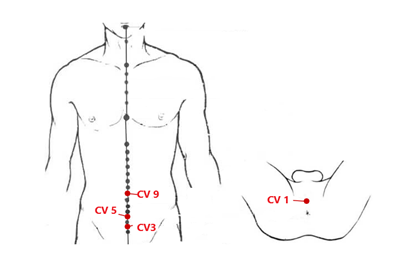
CV1 (会阴 Huì yīn): Meeting of Yin
The Marvellous Vessels are not to be outdone when it comes to treating Dampness. CV1 is not usually a point we treat in Shiatsu, but it’s good to know that it also works in this particular case. Located between the anus and the sex, at the perineum, it is the Luo point of the Conception Vessel. It drains the Heat-Moisture, calms the Shen and restores consciousness. It is also said to bring drowned people back to life. Quite a story…
- Used as a local point for problems with micturition and defecation
- Spermatorrhoea, impotence, genital problems
- Haemorrhoids
- Amenorrhoea, irregular periods, prolapsed uterus
- Coma, suffocation by drowning
- Manic-depressive disorders
- Pain and itching of the skin of the abdomen
CV3 (中极 Zhōng jí): Central Pole
This is the Mu point of the Bladder which promotes diuresis, regulates the Bladder and the genitals. It is therefore a good point for making urine correctly and evacuating it. It is not, therefore, a point of Dampness per se, but one which will support the action of its evacuation. It is located just 1 cun above the pubis.
- Treats all disorders of the urinary system: incontinence, anuria, cystitis, etc.
- And those of the gynaecological system: impotence, spermatorrhoea, leucorrhoea, uterine pain, etc.
- As well as all illnesses caused by dampness: jaundice, leucorrhoea, mucus, morning diarrhoea, etc.
- Also used in cases of sterility, swollen prostate, retained placenta, testicular pain.
CV5 (石门 Shí mén): Stone Gate
Another Mu point, that of the Triple Warmer, which is also the Way of the Waters. Found 2 cun below the umbilicus, it activates circulation in the Waterway, regulates the Uterus and relieves pain. It is therefore another point which sets water in motion.
- Plenitude in the urogenital system, painful urinary disorders, oedema
- Diarrhoea with poorly digested food
- Pain and itching of the genitals
- Uterine bleeding, rock-hard lower abdomen (hence the name)
CV9 (水分 Shuǐ fèn): Water Devide
It eliminates stagnant Dampness, promotes diuresis, particularly in cases of water accumulation in the abdomen (abdominal ascites). It is found at 1 cun just above the abdomen. It is only a Dispersion point for evacuating water and Cold-Moisture.
- Treats dysuria and oliguria
- Eliminates abdominal ascites
Governing Vessel
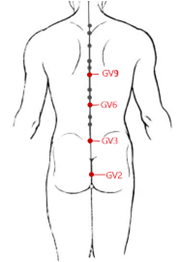
GV2 (腰俞 Yāo yú): Lumbar Shu (Transporting)
We’re now on the Governor Ship. Its second point is at the sacro-coccygeal joint, at the lower opening of the sacral canal, between S4 and S5. It chases away the Wind-Humidity and has beneficial effects on the lumbar region.
- Pain in the lower back or sacrum, or in the hips when flexing or extending is impossible
- Pain when sitting down
- Irregular menstruation, red and white leucorrhoea
- Substantial urine
- Haemorrhoids
GV3 (腰阳关 Yāo yáng guān): Lumbar Yang Pass
It drives out Wind-Humidity, has effects on the lumbar region and legs, regulates the Lower focus. It is located under L4.
- Useful when it is impossible to bend or extend the knee, or when there is pain on the outside of the knee.
- Painful obstruction syndrome type Wind with numbness, contracture of tendons, inability to walk
- Pain in crotch and lumbar region due to exhaustion
GV6 (脊中 Jí zhōng): Spinal Center
Below T11, this point strengthens the Spleen and drains Dampness. It also has beneficial effects on the spine.
- It is used in cases of abdominal fullness, with no pleasure in eating
- Abdominal lumps
- Jaundice, diarrhoea, all types of haemorrhoids, prolapsed rectum in children
- Stiffness of the lumbar spine
- Wind-type epilepsy
GV9 (至阳 Zhì yáng): Extremity of Yang
Located below T7, this point disperses the Heat-Humidity in jaundice (5 types of jaundice), frees the chest and regulates the Median focus. It is also a point for evaluating heart disease.
- It is used for acute stomach pains.
- Eliminates cold from the stomach when there is weight loss and an inability to eat.
- Heaviness, pain and weakness in all four limbs
- Dermatitis due to Heat-Humidity
- Intercostal neuralgia blocking breathing
- Palpitations
- Asthma
- Pain and distension of the hypochondria
Sources
- Atlas d’acupuncture pratique et aide-mémoire du praticien. Alain Dubois, Guy Trédaniel 2016
- L’esprit des points. Philippe Laurent, éditions You Feng, 2010
- Atlas of acupuncture. Claudia Folks and Sylviane Burner, Elsevier Masson, 2009
- Acupuncture: the essential points. Philippe Sionneau, Guy Trédaniel, 2000
- YinYanghouse.com
- Functional classification of acupuncture points. On Zhongyi.net
Author
- Anpuku Workshop with Ivan Bel in London – 7 & 8th, June 2025 - 22 June 2024
- Summer intensive course: back to the roots of Shiatsu – 7 to 13 July 2024, with Ivan Bel - 27 December 2023
- Interview with Wilfried Rappenecker: a european vision for Shiatsu - 15 November 2023
- Interview : Manabu Watanabe, founder of Shyuyou Shiatsu - 30 October 2023
- The points that chase away Dampness - 11 June 2023
- Interview Mihael Mamychshvili: from Georgia to Everything Shiatsu, a dedicated life - 22 April 2023
